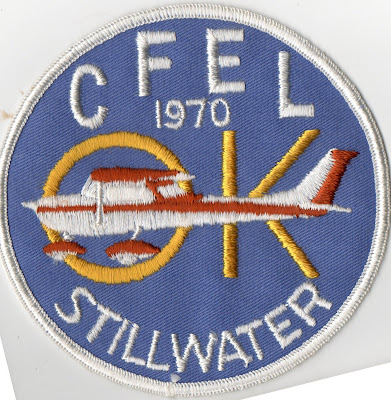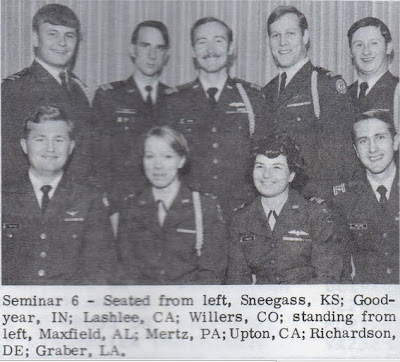Thomas Lawson McCall 1913 - 1983



Below, circa 1970, the Civil Air Patrol and the Governor, from left to right: Cadet Busig, Cadet Kenny, Lt. Col. Dorothy M. Swain, Oregon Governor Tom McCall, Colonel Obed A. "Pancho" Donaldson (CAP Hall of Honor Inductee), Air Force Major James Bassett, Oregon Wing Liason Officer:

Below from 1970, Oregon Wing cadet captain Gorham captures top honors during Civil Air Patrol's 14th annual Jet Orientation Course at Perrin Air Force Base in Texas. He got to fly in a TF-102 supersonic jet trainer:

1968 - Oregon Wing rangers McKee and Gorham inspect a jet engine at Fairchild Air Force Base:

What the well dressed Civil Air Patrol cadet wore in 1969, standing left to right, cadets Huey, Rosenberry, Busig, Lien, Davis, McKee and Gorham and fashion courtesy of Larry M. Newman (in front with white ascot), Director of Ground Training, Oregon Wing:

 (Picture is of Wally Olson, former owner, Evergreen Airport) Below is the logo we Civil Air Patrol cadets designed at the Cadet Flying Encampment License (CFEL) in Stillwater, Oklahoma in the summer of 1970. We stayed on the campus of Oklahoma State University. I remember the person originally selected from Oregon had not passed her FAA written for her pilots license. I had passed the written but had not soloed. So I had two days to solo (my instructor, Wally Olson, let me solo in a taildragger) and get on a plane for CFEL. Total cost to me: $99 for a month of board and room. Result: Pilots License. Very demanding month of flying but fun. The previous year I had went to Malaysia for a month on the International Air Cadet Exchange. When I got my packet telling me I was going to Malaysia, there were race riots going on there. After being reassured they were not killing Americans, off I went for a month in beautiful Malaysia:
(Picture is of Wally Olson, former owner, Evergreen Airport) Below is the logo we Civil Air Patrol cadets designed at the Cadet Flying Encampment License (CFEL) in Stillwater, Oklahoma in the summer of 1970. We stayed on the campus of Oklahoma State University. I remember the person originally selected from Oregon had not passed her FAA written for her pilots license. I had passed the written but had not soloed. So I had two days to solo (my instructor, Wally Olson, let me solo in a taildragger) and get on a plane for CFEL. Total cost to me: $99 for a month of board and room. Result: Pilots License. Very demanding month of flying but fun. The previous year I had went to Malaysia for a month on the International Air Cadet Exchange. When I got my packet telling me I was going to Malaysia, there were race riots going on there. After being reassured they were not killing Americans, off I went for a month in beautiful Malaysia:

Civil Air Patrol history: On January 7 through 10, 1971 at the Statler Hilton in Dallas, Texas the first National Cadet Advisory Council met. From left, Cadet Colonel Tony Upton (1950-2010), Pacific Region; Cadet Lt. Col. Larry Willers, Rocky Mountain Region; Cadet Lt. Col. Stephen Graben, Southwest Region; Cadet Lt. Col. Diana Goodyear, Great Lakes Region; Cadet Lt. Col. Donald Maxfield, Southeast Region; Brigadier General Samuel Hallock duPont, Chairman, Civil Air Patrol; Cadet Colonel Thomas Richardson, Middle East Region and Cadet Colonel Harry Mertz, Northeast Region:

-------
CIVIL AIR PATROL HALL OF HONOR INDUCTEES:
Brig. Gen. Warren J. Barry, CAP
Maj. Gen. Lucas V. Beau, USAF
Col. Joseph S. Bergin, CAP
Brig. Gen. Johnnie Boyd, CAP
Maj. Gen. Richard L. Bowling, CAP
Brig. Gen. D. Harold Byrd, CAP
Col. James C. Carter, CAP
Brig. Gen. Thomas C. Casady, CAP
Brig. Gen. Lyle W. Castle, CAP
Col. Obed A. “Poncho” Donaldson, CAP
Brig. Gen. S.H. “Hal” DuPont Jr., CAP
Col. Guy P. Gannett, CAP
Dr. Paul E. Garber
Col. Robert H. Herweh, CAP
Brig. Gen. Earle E. Johnson, CAP
Col. Clara E. Livingston, CAP
Col. Edwin Lyons, CAP
Lt. Col. William D. “Bill” Madsen, CAP
Col. Larry D. Miller, CAP
Col. Louisa S. Morse, CAP
Col. Zack T. Mosely, CAP
Brig. Gen. William M. Patterson, CAP
Col. Alan C. Perkinson, CAP
Brig. Gen. F. Ward Reilly, CAP
Mr. John V. “Jack” Sorenson
Gen. Carl A. “Tooey” Spaatz, USAF
Dr. Mervin K. Strickler Jr.
Col. Troy G. Sullivan, CAP
Brig. Gen. Paul W. Turner, CAP
Col. Gordon T. Weir, CAP
Brig. Gen. William C. “Cecil” Whelen, CAP
Mr. Gill Robb Wilson
Col. Lester Wolff, CAP
Jack Sorenson and Pancho Donaldson inducted into the Civil Air Patrol Hall of Honor in 1987:

------
Hey, you look familiar, aren't you General Spaatz? - After just receiving his Spaatz Award, this cadet meets a true gentleman, General Carl "Tooey" Spaatz, cadet was from the Vancouver Composite Squadron, CAP (picture taken at the Civil Air Patrol National Board Banquet at the Statler Hilton Hotel, Washington D.C. on Saturday night, October 10, 1970):












General Carl Spaatz, first Chief of Staff of the U.S. Air Force died July 14, 1974 of congestive heart failure at Walter Reed Medical Center. He was 83.
He was appointed Chief of Staff by President Harry S. Truman in September 1947 when the Air Force became a separate branch of the military service.
As the Commander of Strategic Air Forces in the Pacific during World War II, he supervised the final bombing of Japan. He participated in combat in all theaters during the war and was present at all three surrender ceremonies that ended the war.
General Spaatz was born in Boyertown, Pennsylvania, was graduated from West Point in 1914 as an infantry officer. His first contact with aviation occurred in 1915 when he was detailed to the aviation school in San Diego. He earned his wings in 1916 and served with General Pershing in the punitive expedition into Mexico.
The then Captain Spaatz went to France in World War I as commander of the 31st Aero Squadron. His capability for organization resulted in his being put in charge of the aviation instruction center at Issoudon.
At the time of Pearl Harbor, he was a brigadier general. He was promoted to major general and given command of the U.S. Strategic Air Forces in Europe from before the invasion of France until final victory. After that he moved to the Pacific.
Since his retirement in 1948, General Spaatz had made his home in Chevy Chase, Maryland. He is survived by his wife, Ruth Harrison Spaatz; three daughters and eleven grandchildren.
January 1975, Number 81
Reichsmarschall Hermann Wilhelm Göring and General Carl "Tooey" Spaatz:
Strategic Air Power, 1946 Foreign Affairs article by General Carl Spaatz
A Reflection on the Causes of the German Defeat by Generaloberst Lothar Rendulic
Movie: Der Untergang (Downfall) with English subtitles
Hitler's Secret Archive
-----
Below, the Right Stuff: NASA Astronaut and Air Force Col Eric Boe, Spaatz #648, proudly displays the Spaatz Association commemorative challenge coin he carried into orbit aboard the space shuttle Endeavour during STS-126 in November 2008. NASA photo.

Below: These seven astronauts take a break from training to pose for the STS-126 crew portrait. Astronaut Christopher J. Ferguson, commander, is at center; and astronaut Eric A. Boe, pilot, is third from the right. Remaining crew members, pictured from left to right, are astronauts Sandra H. Magnus, Stephen G. Bowen, Donald R. Pettit, Robert S. (Shane) Kimbrough and Heidemarie M. Stefanyshyn-Piper, all mission specialists. NASA Photo.

Below, Colonel Eric A. Boe pilots the space shuttle Endeavour to a perfect landing on November 30, 2008 (STS-126):
-------
Diamonds are Forever:
------
History moment - John F. Kennedy - three shots fired, no magic bullet, Lee Harvey Oswald was the lone gunman, watch the entire 88 minute program:

 Kennedy Assassination weirdness: Brig. General David Harold "Dry Hole" Byrd, a Civil Air Patrol Hall of Honor inductee, was an incorporator of the Civil Air Patrol along with Gill Robb Wilson and others in 1941. Brig. General Byrd also owned the Texas School Book Depository building from the 1930's and at the time of the JFK assassination; Byrd had the window from which former Civil Air Patrol cadet Lee Harvey Oswald allegedly shot at JFK removed and mounted on the wall of his home. We don't believe General Byrd had any prior knowledge of the assassination; General Byrd was out of the country when President Kennedy was killed. The author of a recent assassination book called "Family of Secrets," Russ Baker, calls the Civil Air Patrol a "paramilitary organization." Mr. Baker needs to learn something about the Civil Air Patrol:
Kennedy Assassination weirdness: Brig. General David Harold "Dry Hole" Byrd, a Civil Air Patrol Hall of Honor inductee, was an incorporator of the Civil Air Patrol along with Gill Robb Wilson and others in 1941. Brig. General Byrd also owned the Texas School Book Depository building from the 1930's and at the time of the JFK assassination; Byrd had the window from which former Civil Air Patrol cadet Lee Harvey Oswald allegedly shot at JFK removed and mounted on the wall of his home. We don't believe General Byrd had any prior knowledge of the assassination; General Byrd was out of the country when President Kennedy was killed. The author of a recent assassination book called "Family of Secrets," Russ Baker, calls the Civil Air Patrol a "paramilitary organization." Mr. Baker needs to learn something about the Civil Air Patrol:

Below, Brigadier General David Harold "Dry Hole" Byrd, CAP and General Doolittle on safari:

I personally take comfort in the Lee Harvey Oswald Lone Nut Theory, but here is another view:
Lee Harvey Oswald is dropped off at work by a friend on the morning of November 22, 1963. He has with him some wrapped up "curtain rods." The rifle that fired the 3 shots was Oswalds, the bullets match his gun. His prints are on the gun, he was trained by the Marines to shoot and before the day was up he killed a cop. Lee Harvey Oswald was the lone assassin of JFK:
<
Strange moments of What's My Line with Dorothy Kilgallen:
Dorothy Kilgallen's father on What's My Line:
Dorothy Kilgallen's children on What's My Line:
-----
Everything you wanted to now about the plague - Part one:
Many cemeteries show gravestones of young people who died in October 1918. Schools were shut down and police officers wore masks. Millions died in the 1918 flu pandemic. Young people would get sick in the morning and be dead that night:
------
December 21, 2012 - Does it all end then?:
------
BS - John Hogue - This guy charges for his predictions???
------
Civil Air Patrol Advance Cadet Leadership Symposium, January 7-10, 1971 at the Statler Hilton in Dallas, Texas. Attendees:







To learn about the history of the Civil Air Patrol, read the Flying Minute Men by Robert E. Neprud.
------
The Oregon Wing and the Weaverville, California Search - January and February 1970
In late January 1970, 75 members of the Oregon Wing of the Civil Air Patrol went to northern California (Robert Kadow was the Oregon mission commander) to look for a Piper PA-28 (N7960W) that had been missing since January 9, 1970 on a flight from Medford, Oregon to Napa, California. When we crossed the California border, the California Highway Patrol pulled over the convoy of blue vehicles and inquired about our license plates (they were white with handwritten numbers on it). The plates were not official Oregon State plates, and the Highway Patrol was confused about our mission. Things were soon to turn tragic, as a search plane crashed (N51144) killing three searchers aboard. After the crashed search plane was located, the search for the original aircraft was called off. It was later found in the Spring of 1970. Searching for 3 souls, 3 searchers died. Tragic. The Oregon Wing involvement was between January 30 and February 4, 1970.
-----

No comments:
Post a Comment